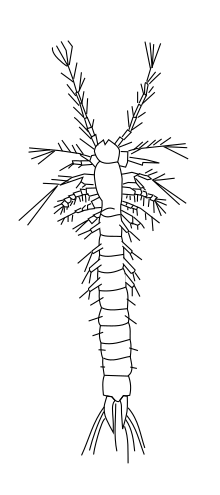Mystacocarida
Mystacocarida is a subclass of crustaceans, that form part of the meiobenthos. They are less than 1 mm (0.04 in) long, and live interstitially in the intertidal zones of sandy beaches.
| Mystacocarida | |
|---|---|
 | |
| Unspecified member of Mystacocarida. | |
| Scientific classification | |
| Kingdom: | Animalia |
| Phylum: | Arthropoda |
| Subphylum: | Crustacea |
| Class: | Maxillopoda |
| Subclass: | Mystacocarida Pennak & Zinn, 1943 |
| Order: | Mystacocaridida Pennak & Zinn, 1943 |
| Family: | Derocheilocarididae Pennak & Zinn, 1943 |
| Genera | |
| |
Taxonomy
The taxonomy of the Mystacocarida is extremely conservative, since all mystacocarids look superficially alike. As of October 2012, the 13 described species are divided between two genera, Derocheilocaris (eight species) and Ctenocheilocharis (five species).[1][2] The first mystacocarids to be found were discovered on a beach in southern New England in 1939.[3]
Distribution
Mystacocarids occur along the coasts of South and North America, southern Africa, and the western Mediterranean.[4] The lack of records from other parts of the world is "almost certainly" due to a lack of appropriate sampling, rather than a true absence.[2]
Description
Mystacocarids are tiny crustaceans, less than 1 mm (0.039 in) long, that live in the spaces between sand grains on intertidal beaches.[3] They have a cylindrical body, with five thoracic and five abdominal segments. Four pairs of small thoracic appendages are seen.[5]
The head is relatively large and divided into two by a stricture, so that the latter part gives the appearance of being a part of the thorax. This region bears a pair of maxillipeds, and the head also has two pairs of maxillae, a pair of limb-like mandibles, and two pairs of long antennae. The appendages on the head are much longer than those on the thorax, and have a number of fine hairs that the animal uses to strain detritus from the water to feed on. They have a single naupliar eye.[5] After mating, mystacocarids lay tiny eggs which hatch into a nauplius or metanauplius larva.[4]
References
- "WoRMS Mystacocarida: World List of Mystacocarida". 2012 Annual Checklist. Catalogue of Life. March 15, 2012. Retrieved October 24, 2012.
- Joel W. Martin (2009). "Cephalocarida and Mystacocarida (Crustacea) of the Gulf of Mexico". In Darryl L. Felder & David K. Camp (ed.). Biodiversity. Gulf of Mexico: Origin, Waters, and Biota. 1. Texas A&M University Press. pp. 821–824. ISBN 978-1-60344-094-3.
- James T. Carlton & Joel W. Martin (2007). "Mystacocarida". In James T. Carlton (ed.). The Light and Smith manual: intertidal invertebrates from central California to Oregon (4th ed.). University of California Press. p. 413. ISBN 978-0-520-23939-5.
- J. K. Lowry (October 2, 1999). "Mystacocarida (Maxillipoda)". Crustacea, the Higher Taxa. Australian Museum. Archived from the original on September 28, 2011. Retrieved July 25, 2011.
- Robert D. Barnes (1982). Invertebrate Zoology. Philadelphia, PA: Holt-Saunders International. pp. 692–693. ISBN 978-0-03-056747-6.